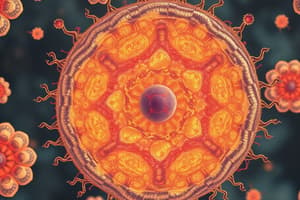Podcast
Questions and Answers
What is a primary characteristic that distinguishes prokaryotic cells from eukaryotic cells?
What is a primary characteristic that distinguishes prokaryotic cells from eukaryotic cells?
- Prokaryotic cells lack a nucleus. (correct)
- Prokaryotic cells have multiple, linear chromosomes.
- Prokaryotic cells contain membrane-bound organelles.
- Prokaryotic cells are generally larger.
Which of the following statements about the structure of plant cells is accurate?
Which of the following statements about the structure of plant cells is accurate?
- Plant cells have a plasma membrane that is thicker than fungi cell walls.
- Plant cells contain a rigid cell wall composed of cellulose. (correct)
- Plant cells have many small vacuoles instead of a central vacuole.
- Plant cells lack a cell wall.
What type of cell division occurs in eukaryotic cells?
What type of cell division occurs in eukaryotic cells?
- Mitosis and meiosis. (correct)
- Meiosis only.
- Fragmentation.
- Budding or binary fission.
Which statement regarding the cell membrane is true?
Which statement regarding the cell membrane is true?
Which of the following correctly describes the organization of chromosomes in prokaryotic cells?
Which of the following correctly describes the organization of chromosomes in prokaryotic cells?
Flashcards
Prokaryotes
Prokaryotes
Cell types generally small, without a nucleus and organelles.
Eukaryotes
Eukaryotes
Cell types that are generally large, containing a nucleus and organelles.
Cell Wall
Cell Wall
Rigid structure providing shape in plant cells, composed mainly of cellulose.
Cell Membrane
Cell Membrane
Signup and view all the flashcards
Chromosomes in Prokaryotes
Chromosomes in Prokaryotes
Signup and view all the flashcards
Study Notes
Prokaryotes vs. Eukaryotes
-
Prokaryotes:
- Generally small cells
- Lack a nucleus
- Contain a single, circular chromosome
- Lack membrane-bound organelles
- Cell division occurs by fission or budding
-
Eukaryotes:
- Generally large cells
- Possess a nucleus
- Contain multiple linear chromosomes
- Have membrane-bound organelles
- Cell division occurs by mitosis and meiosis
Cell Structure
- Cell Wall:
- Found in plant cells
- Rigid structure
- Non-living
- Made of cellulose or chitin
- Provides shape and rigidity
- Plant cell wall is permeable
- Cell Wall of Bacteria:
- Made up of peptidoglycan
- Cell Membrane:
- Also known as plasma membrane
- Forms the outer covering of animal cells
- Found within the cell wall in plant cells
- Thin, elastic, living
- Double layer
- Permeable membrane
- Composed of lipids and proteins
- Major lipids are phospholipids
- Arranged in a bilayer
Nucleus and Related Structures
- Nucleus:
- Contains chromatin
- Chromatin is made up of DNA and histone protein
- Nucleolus:
- Present inside the nucleus
Studying That Suits You
Use AI to generate personalized quizzes and flashcards to suit your learning preferences.




